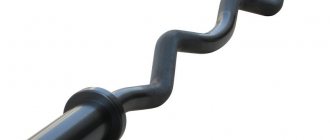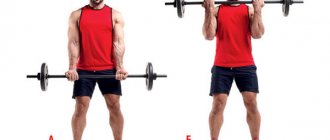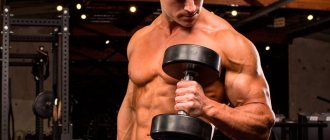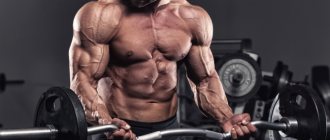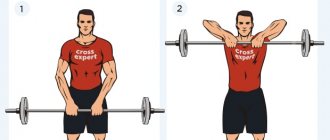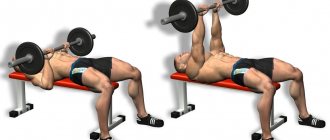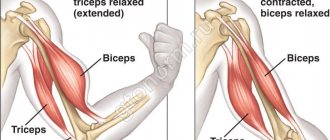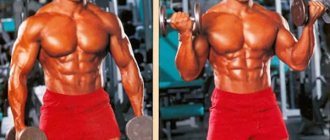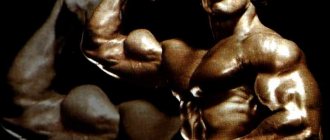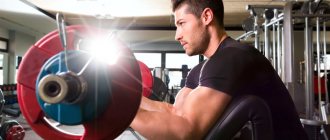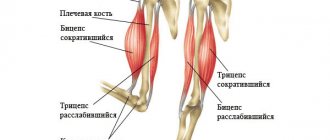Legs | Back | Chest | Shoulders | Triceps | Biceps | Press
Over the years, a number of studies have focused on the best biceps exercises. This shouldn't surprise you! Surely you know that the first thing you would do if you had access to an EMG machine would be to connect it to your biceps. Be honest.
So what is the winner? Judging by biceps EMG alone, these are typically concentrated bicep curls, which were a staple of the bodybuilding exercises of golden-era athletes like Arnold Schwarzenegger and Lou Ferrigno. But here's the rub: there isn't a single bodybuilder who completely agrees with this.
Why not? First, experienced athletes know that while muscle activation is an important factor, it is not the only factor in determining the best exercises to build the biceps brachii muscles. Instead, this article provides a number of options for selecting the top 10, including:
- Easy to learn and perform
- General muscle stimulation and intensity
- Popular among professional athletes and bodybuilders (This is important!)
- Availability of equipment in gyms
You should not consider this list to be absolute. Take this as a starting point for discussion, and then experiment for yourself over the next three sessions!
Raising dumbbells from the shoulders
In this case, when performing, not only the shoulders are worked out, but also the deltoid muscles. The exercise can be done standing or sitting on a regular bench or abdominal bench.
- Starting position – standing with a straight back.
- Take dumbbells in your hands. It is important that your palms are turned inward.
- Raise your arms with dumbbells to shoulder level and take a deep breath.
- Exhale, fixating at the top point.
- As you inhale, return your arms to the starting position.
Number of repetitions – 30.
Basic mistakes
Speed
You can regularly see beginners doing reverse-grip barbell curls (or any standing barbell curl) at a fast pace. This is ineffective and dangerous. In this style, you distort the technique; speed prevents you from doing the exercise correctly.
You may injure your biceps tendon. You can also break your back, since when performed quickly, the load will unnoticeably transfer to your lower back (for example, to dampen inertia when lowering the weight).
Do reverse-grip barbell curls or any biceps curl smoothly and correctly. For greater certainty, we present the optimal frequency of execution: 2 repetitions every 3-4 seconds.
Cheating
When a person takes too much weight, no matter with a narrow or wide grip, he throws it with the help of movements of the legs, pelvis, and body. Then at the top point he intercepts it with the muscles of his arms and lowers it back. Typically, the weight simply falls back to the starting position because the practitioner does not have enough strength to make the movement smoothly.
The moment you catch the barbell with your biceps, you can damage them. When you throw weights every time you move your body, you risk tearing your lower back. Instead of spending energy on a specific exercise, the body is sprayed on everything except the biceps workout itself.
Therefore, cheating will not lead to results in terms of muscle growth. Perhaps a one-time lift will be performed with impressive weight. But do you have a different goal for visiting the gym? Your actions must be consistent with your goals. Let's do the exercise in strict accordance with his technique.
Grip problems
When your biceps have enough strength to handle the weight you've chosen, but your wrists don't, problems begin. The wrists cannot maintain a straight line between the elbow and the fist. The arm begins to bend, and the barbell hangs.
Lifting the barbell for biceps with a reverse grip solves this problem, but with a straight grip it is more difficult. If this happens, give up the direct grip, try curling your arms with a barbell while standing with a reverse grip.
Additionally, practice exercises that specifically develop grip strength.
Dumbbell overhead press (French press)
By including this exercise in your training, you will perfectly pump up your triceps. In addition, you can use a cable instead of dumbbells.
- Starting position – sitting on a bench with or without a backrest.
- Hold a dumbbell in both hands, then, with your elbows fully straight, lift it above your head.
- From this position, begin to lower the dumbbell behind your head, bending your elbows.
- Hold for a couple of seconds, and then return to the original position.
Number of repetitions – 20.
Dumbbell biceps curl
This is a simple and effective way to pump up your biceps, which will make your upper body more proportional.
- Starting position – feet shoulder-width apart, dumbbells in hands.
- Straighten your arms and then pull the dumbbells toward your shoulders.
- Hold this pose for 10 seconds.
- Smoothly, without jerking, lower your arms.
Number of repetitions – 30.
Basic exercises with a barbell
So let's get straight to the list.
Bench press
Execution technique : to take the starting position, lie on a bench, place your feet on the floor and hold the barbell with your arms outstretched at chest level. Press your shoulders into the bench, tighten your glutes, bend your arms and lower the barbell to your chest, and then lift it back up.
Target muscles : chest, triceps, front deltoids
The simultaneous activation of the chest, shoulders and triceps muscles makes this basic exercise, along with deadlifts and squats, one of the best tests of strength. Here you can give much more load to the triceps than in push-ups or crossover extensions.
The bench press also works the upper back muscles. Make sure that your shoulder blades remain motionless and pressed against the bench. This tension will keep you stable when lifting heavy weights. It is to strengthen this position that sometimes powerlifters even lift their hips off the bench in order to press their shoulder blades into it even more.
Correct muscle imbalances
If you have strong chest muscles but weak shoulder stabilizers, you will have difficulty lifting heavy weights into the bench press. In this situation, the one-arm dumbbell press is a great option for you, as this exercise requires a lot of control in the shoulder joint, as well as a strong core to balance the weight. If you have an imbalance in muscle development, then devote 1 day a week to eliminating it, and then it will quickly become a thing of the past.
Additional exercises
The best complementary exercises to the bench press are dips or close-grip presses, which work the same muscles but from a different angle. Once you can complete 10 bodyweight reps without breaking technique, begin adding weights to your belt or holding a dumbbell between your legs.
Bent-over barbell row
Technique : Grasp the bar with a shoulder-width grip, bend your knees slightly and bend over so that your torso is at an angle of 45° to the floor. Pull the bar towards you, touching your stomach, and then slowly lower it back. If your upper body moves during the exercise, your weight is too heavy.
Target muscles : biceps, lats, core
You should spend the same amount of time training your back as you do your chest. The main exercise here is the bent-over row, as it is an effective way to develop upper body strength and add dimension to the back. Not only does it require significant pulling power, but also the ability to maintain a stable flexed position, which helps strengthen the erector spinae muscle, which is part of the core.
Watch the position of your shoulder blades
If you want to lift heavy weights and effectively train all the target muscles, you must pay special attention to the starting position. As you begin the bent-over row, tighten your shoulder blades and pull them back and down, and stick your chest out so your elbows can move freely along your sides. You can also try a partial grip (thumbs on top of the bar), which will allow more active use of the latissimus dorsi muscles.
Common Mistakes
“First, many lifters use their biceps rather than their lats to pull weights,” Wright says. – Secondly, the weight chosen is too heavy, which leads to poor technique and reduced range of motion. Doing repetitions too quickly can also hinder progress. Remember that in order for a muscle to grow, it needs to be under tension for about 40 seconds.”
Underhand grip
Once you learn how to perform the movements correctly, you can start experimenting with different variations of the exercise. For example, if you want to build bigger lats and strengthen your lower back, try using an underhand grip with a narrow hand placement. It also allows for more active use of the biceps. By the way, bent-over barbell rows are more effective for building the latissimus dorsi muscles than lat pulldowns to the chest.
Perform one-arm dumbbell rows
“This is my favorite complementary exercise to the bent-over row,” says Wright. – Take a dumbbell in one hand, place the other on a bench and spread your legs wide. Pull the dumbbell back and up so that it moves in a curved path towards the lower part of the chest. This exercise allows for a greater range of motion and is great for developing your core and obliques.”
Deadlift
Technique : spread your feet shoulder-width apart and grab the bar so that your hands are on the outside of your legs. Keeping your back straight, push your pelvis forward and lift the barbell. Lower the barbell slowly, although once you start lifting heavy weights, you may want to drop it to the floor at the end of the last rep.
Target muscles : all muscle groups of the body
The deadlift is the best exercise for developing strength. It allows you to lift more weight than any other barbell exercise and works all of your posterior chain muscles.
More about the technique
Although the deadlift may seem like a simple exercise at first glance, there are many mistakes made when performing it. “Poor technique fails most average athletes and can lead to serious injury,” says Wright. – When lifting weights, move your shoulders back, push your chest forward, and squeeze your shoulder blades together. This creates tension in the back, which helps prevent the lower back from rounding or pushing the pelvis forward too early. Also, tighten your buttocks and push off the floor with your heels.”
Progress
Even if you are a beginner athlete, you will progress quickly and will soon reach 100 kg in your working weight. And then the question of the correct technique will become especially important. If you have a limp, then perform deadlifts in a power rack, placing the barbell at a height of about 30cm from the floor. This way you will develop strength through a shorter range of motion. Once you can perform each repetition correctly, you can increase the speed at which you lift the barbell.
To improve your speed, perform heavy kettlebell swings. This will help you strengthen your buttocks and thighs, which will have a positive effect on your deadlift results.
Squats with a barbell on your shoulders
Technique : Place the barbell on the racks and stand under it so that the bar is on your shoulders. Take 2 large steps back and place your feet shoulder-width apart, toes pointed slightly outward. Keeping your back straight, lower yourself into a squat as if you were sitting in a chair until your hips are below your knees. Stand up, pushing off the floor with your heels.
Target muscles : quadriceps, glutes, hamstrings
“Whether you like it or not, strength will always be determined by your squat performance,” says Wright. “The reason for this is the fact that this exercise works both the lower and upper body at the same time.”
Avoid partial repetitions
You've probably seen people in the gym putting huge weights on the bar and doing partial reps. In fact, they are wasting their time. For a proper squat, your hips must go down to at least knee level. If you do partial repetitions, the muscles will not receive the proper stimulus to grow. Warm up for 5-10 minutes before you begin squats to ensure you move through a full range of motion with proper depth to improve results and avoid injury.
Benefits for all parts of the body
Although squats are primarily a leg exercise, the upper body also participates and plays an increasingly important role as weight increases. “A simple way to make sure it's done correctly is to make sure your back is straight and your chest is facing forward,” Wright says. – You can also lower the bar just below your shoulders and point your elbows forward to reduce the stress on your legs and core. You will be surprised at how the nature of the exercise changes.”
Do Bulgarian split squats
A strength imbalance between the left and right sides of the body will most likely lead to poor technique and ultimately injury. To avoid such negative consequences, perform unilateral exercises. “After the classic squats, move on to the Bulgarian split squat,” says Wright. – Holding dumbbells in your hands, take one leg back and place it on the bench. Lower yourself into a squat, keeping your front shin upright. This exercise develops your leg muscles as well as your balance, which will help you when performing squats with a barbell on your shoulders.”
Military standing barbell press
Technique : stand straight, place your feet shoulder-width apart, place the barbell on your upper chest, with your arms slightly wider than shoulder-width apart. Tighten your abs, glutes, and quads. Raise the barbell above your head, pause, and then lower it back down. You may find that you lift more weight if you grip the bar with an open grip (thumbs on top of the bar).
Target muscles : shoulders, triceps
The military press requires strength and balance, as well as good mobility in the shoulders. The exercise strengthens the deltoid and back muscles, which has a positive effect on bench press results.
Center of gravity
To lift the heaviest weight possible, lift the bar straight above your head. “The center of gravity should be through your head, upper spine, hips and ankles,” says Wright. – Keep them in one line, tensing the muscles of the abdomen and buttocks. This will also allow you to increase your working weight by about 10%.”
Overhead press
To perform a military press correctly, you must be able to retract your shoulder blades and extend your arms so that your elbows are directly under the bar. To develop this ability, try doing overhead presses. This variation will work your rear delts and back better, but you will need to reduce the weight by about 30% and use a slightly wider grip.
T-bar press
The shoulder joints are quite vulnerable because they are very mobile and include a group of small stabilizing muscles called the rotator cuff. “To strengthen them, follow the military press with a T-bar press,” says Wright. To do this, rest one end of the bar in the corner of the room, and take the other in your hand and extend it above your head. Remember to keep your abdominal muscles tense.”
Lunges with a barbell
Technique : Place the barbell on your shoulders, stand straight, retract your shoulder blades and tighten your core muscles. Take a big step forward and lower your torso until both legs are bent at a 90-degree angle, then push off with your front leg to return to the starting position.
Target muscles : quadriceps, glutes, hamstrings
“Lunges have many variations and can work all muscle groups in the lower body,” says Wright. “This is one of the most underrated exercises for developing athletic ability.”
Tension in the torso
Although lunges primarily target the lower body, they actually place stress on the entire torso as well. The more you tighten your torso muscles, the more stable your position will be. Try to pull your abdominal muscles in as much as possible and push your shoulders back before lunging. Shallow lunges will put more stress on the quadriceps, while deep lunges will put more stress on the hips and buttocks. If the shin protrudes forward, then the emphasis is on the front of the leg; if not, then on the posterior chain.
Perform reverse lunges to progress
Reverse lunges have many benefits, including developing balance and coordination. "If you're struggling with regular lunges, it could be due to tight hip flexors or ankles, so reverse lunges can be a real lifesaver," says Wright.
The benefits of long lunges
“To build strength and speed, I do long lunges and push my heels off the floor, squeezing my glutes,” Wright says. – Without stopping at the top phase of the exercise, I immediately move on to the next lunge. It's more like running in slow motion. This approach helps maintain core tension and build strength and power.”
Barbell clean
Technique : Place the barbell on the floor and grab the bar with your hands shoulder-width apart. Push your heels off the floor, begin to lift the barbell, and when it is at knee level, jerk it (using the inertia of movement) to your chest. Pause and then lower the barbell to the starting position.
Target muscles : whole body
The exercise is aimed at developing power and speed. “The clean has been used by athletes for years to improve performance,” says Wright. “It develops the entire body because it combines deadlifts and hanging cleans.”
Warm-up
It is necessary to perform cleans at the beginning of training, but this does not mean that you should immediately throw 80 kg on the bar and go all out. “Be sure to warm up properly,” says Wright. – Pay special attention to the shoulders and latissimus dorsi muscles. Mobility in the hips is key because when you lift the barbell explosively, you have to quickly push your pelvis forward.”
Hanging clean
If your goal is not to pump up your legs, you can perform hanging cleans (when in the starting position the barbell is held in your lowered hands at hip level, and not on the floor). This variation of the exercise improves your grip strength, which in turn will have a positive effect on your performance in other exercises. “The hanging clean is ideal for when you want to focus solely on your upper body,” says Wright.
Squats with dumbbell presses and box jumps
“These are two exercises I like to do right after the clean,” Wright says. “Box jumps will improve speed and strength, while squats with dumbbell overhead presses allow you to work your lower and upper body at the same time.”
Reverse push-ups
For this workout you don’t even need sports equipment, just a chair, bench or sofa is enough. Reverse push-ups are one of the basic methods to form beautiful arms and strengthen the triceps.
- Starting position – sitting on a chair or bench.
- Place your hands at shoulder level on a bench or chair with your legs extended in front of you.
- Keeping your elbows slightly bent, stand up from the chair and slowly lower your body down. The weight of the body is transferred to the hands.
- Fix the position in which your elbows should create a right angle. Make sure that your shoulders are lowered when lowering and raising your body.
Number of repetitions – 20.
Weight selection
This is a mandatory procedure that precedes any exercise with a barbell. It is extremely important to correctly determine this parameter, otherwise it will not be possible to achieve a positive result in building muscle mass; this is done exclusively through trials and experiments.
To successfully implement this process, the following tips can be given:
- To begin with , set the average weight, for men it is about 40-50 kg, for women 20-25 kg, for beginners it is best to focus on your feelings.
- Try basic exercises; to increase muscle mass, it usually takes from 6 to 12 repetitions; if the selected weight does not allow you to do them, then it must be reduced.
- If after 12 repetitions it is still possible to perform further exercises, and the muscles are not tired at all, then you can try to increase the weight by another 10 kg, since the established load will not be enough for muscle growth.
Dumbbell press with the opposite hand resting on the bench
Another opportunity to pump up your triceps and tighten your arm muscles. To work, you will need dumbbells and any horizontal surface.
- Starting position – with your arms and legs resting on the bench.
- Place your knee and hand on the bench, keeping your foot flat on the floor. It is important that your body is parallel to the surface.
- Hold the dumbbell with your other hand and press your elbow close to your body.
- Extend your elbow and lift your forearm, working your triceps.
- Fix at the end point and return to the starting position.
Number of repetitions – 20.
How to balance training and nutrition?
To achieve the desired effect, it is important to find a balance between exercise and nutrition. The key to losing weight is to eat fewer calories and eat healthier. The diet should be based on the following rules:
- Forget about fried and fatty foods.
- Eat lean meat (turkey, chicken).
- Do not drastically reduce the number of servings or reduce their size. Replace them with fruits and vegetables.
- Eat more protein for breakfast.
- Drink plenty of water.
Healthy food is one of the steps to rejuvenation. Especially after 50 years, when the body is prone to slagging.
Raising arms to the sides
This workout will be extremely useful for those who want to work on their arms, back muscles and deltoids.
- Starting position – standing with a straight back.
- Take dumbbells in your hands and stand straight.
- Squat down slightly, keeping your arms straight, and extend your arms with the dumbbells.
- Hold this position, keeping the dumbbells at shoulder level.
- Slowly lower your arms.
Number of repetitions – 30.
Contraindications
Still, 50 years is a respectable age. Some diseases make themselves felt. This must be taken into account. Before you start sports rejuvenation, you should consult your doctor. Especially if you have the following diseases:
- hypertension;
- arrhythmia;
- heart attack;
- diseases of the spine (osteochondrosis, scoliosis);
- diabetes;
- dysfunction of the thyroid gland.
It’s great if a 50-year-old woman comes to the gym. The instructor will select a program based on her age. But you can successfully fight sagging skin at home. The main thing is not to be lazy, exercise regularly and eat a healthy diet.
2 comments on ““How to remove sagging skin on your hands at home””
- Julia:
04.07.2020 at 13:06
By the age of 30, the skin begins to deteriorate, nothing can be done about it, we don’t get any younger over the years)) It is very advisable to go in for sports, I go to the gym 3 times a week, for me it is so natural that I don’t think about canceling my workouts. Not everyone has a gym nearby, then you can work out at home, just buy a pair of collapsible dumbbells, and now elastic bands, which are sold for weighting, are very affordable. Also, do not forget about stretching; after training, you need to stretch your muscles for at least 15 minutes, this will prevent soreness.
Answer
- Natalia:
08/16/2020 at 23:51
Just after losing weight, the skin on my arms began to sag. A friend advised me to do push-ups, but my back began to hurt, apparently from the stress of being unaccustomed to it. I gave it up for a while. It’s written correctly here - you need to start with a warm-up, and then perform the complex. I liked the exercises with dumbbells - I think the effect will be no worse than push-ups, and also for stretching - it’s good for the back.
Answer
Superman
This intriguingly named exercise works the muscles of your entire body, including your abs, back, arms, shoulders and buttocks.
- Starting position – lying on the floor face down.
- Stretch your arms and legs, relaxing your muscles.
- Begin to lift your limbs, while trying not to lift your body off the floor.
- Stay in this position for 5-10 seconds, then lower yourself to the mat.
- Watch your breathing, inhale, raising your limbs and exhale, lowering them back.
Number of repetitions – 10.
Recommendations
By training your arms, you can develop strength, improve the quality of muscles and work on mass. The training method and choice of exercise depend on this. For biceps exercises with a barbell, it is important to use low-repetition training and work in the range of 12-14 repetitions, which is aimed at developing the volume of the biceps.
The multi-repetition mode for working with a barbell is less relevant, but it is also not excluded, especially if there are no other sports equipment. There shouldn't be a lot of exercises in biceps training. Two or three are enough. If the athlete is a professional, then their number can be 5-6 exercises.
